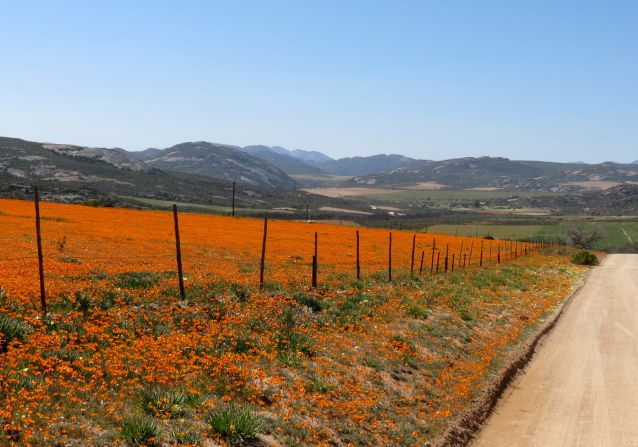
Once a year in South Africa's outback, vast stretches of land suddenly transform into vibrantly colored fields full of exotic flowers. A spring phenomenon that blankets the usually dry region, visitors travel from across the world to view these spectacular landscapes. Whether it be the multi-colored settings in West Coast National Park or the awe-inspiring fields of Namaqualand, these flower beds are assured to take your breath away.
By Monique Todd, for CNN
Namaqualand spring flowers, captured by Chris Preen
By Monique Todd, for CNN
Namaqualand spring flowers, captured by Chris Preen

The rainfall in Namaqualand and the West Coast of South Africa isn't at all consistent. In fact, the region hardly receives much rainfall throughout the year. However, during the winter months of May and July, the land receives its quota of rain. As soon as the warmth of spring arrives from August through to mid-October, the otherwise colorless landscape explodes with flowers both rare and striking.
Pictured is Cape Town's Kirstenbosch National Botanic Garden, on the slopes of Table Mountain, captured by Cameron Bent
Pictured is Cape Town's Kirstenbosch National Botanic Garden, on the slopes of Table Mountain, captured by Cameron Bent

The Cape wild flower season is best viewed between August and late-September, though the bloom is largely dependent on the winds, rain and spring sun. Consistent cold fronts during the winter will produce bountiful flowers and vibrant color. However if the spring gets too hot, the flowers are likely to disappear quicker.
Namaqualand spring flowers, captured by Chris Preen
Namaqualand spring flowers, captured by Chris Preen

"It's all related to nature cycles" says Pierre Nel, a Park Ranger at West Coast National Park. Though the flowers will inevitably wilt away, their return is guaranteed year after year. "The seed remains in the soil until the following year when the whole cycle is repeated."
Postberg Nature Reserve, West Coast National Park, Western Cape, South Africa, captured by Cameron Bent
Postberg Nature Reserve, West Coast National Park, Western Cape, South Africa, captured by Cameron Bent

Every year, this semi-arid region of Namaqualand in the Northern Cape Province, pictured, transforms into blocks of uninterrupted color. More than 4,000 indigenous species flower in this region.

Some flower species, such as yellow Sparaxis, purple Geraniums and Snow Protea, can only be found in the desolate regions of Namaqualand and the Western Cape.
Postberg Nature Reserve, West Coast National Park, Western Cape, South Africa, captured by Cameron Bent
Postberg Nature Reserve, West Coast National Park, Western Cape, South Africa, captured by Cameron Bent

However these flowers do more than just leave visitors in awe, they also act as a sort of shelter for the land so it can reboot for the following dry season.
"Its nature's way of rehabilitating" mentions Nel.
"They cover the land, they cover the soil, protecting it from rain and wind erosion."
The small town of Nieuwoudtville in the Northern Cape
"Its nature's way of rehabilitating" mentions Nel.
"They cover the land, they cover the soil, protecting it from rain and wind erosion."
The small town of Nieuwoudtville in the Northern Cape

Whilst the flowers showcase their vibrancy in the daylight, they get particularly shy when the night beckons. Daylight is the prime time for the flowers to get pollinated by insects, where the light of the day stimulates a chemical reaction allowing them to open.
Namaqualand spring flowers, captured by Chris Preen
Namaqualand spring flowers, captured by Chris Preen

"They open during the day when there is a lot of activity and then in the evenings when it's colder due to lack of sun and lack of warmth" says Nel.
"The chemical reaction then causes it once again to close and they remain closed overnight."
Wild flowers adorn a field, near Springbok, in the northern Cape Province
"The chemical reaction then causes it once again to close and they remain closed overnight."
Wild flowers adorn a field, near Springbok, in the northern Cape Province

Providing a vital boost to the country's economy, visitors travel from across the world to tour the colorful region. It seems that flowers can attract just as much attention as the regions famed lions, elephants and rhinos.
West Coast National Park, Western Cape, South Africa, captured by Cameron Bent
West Coast National Park, Western Cape, South Africa, captured by Cameron Bent